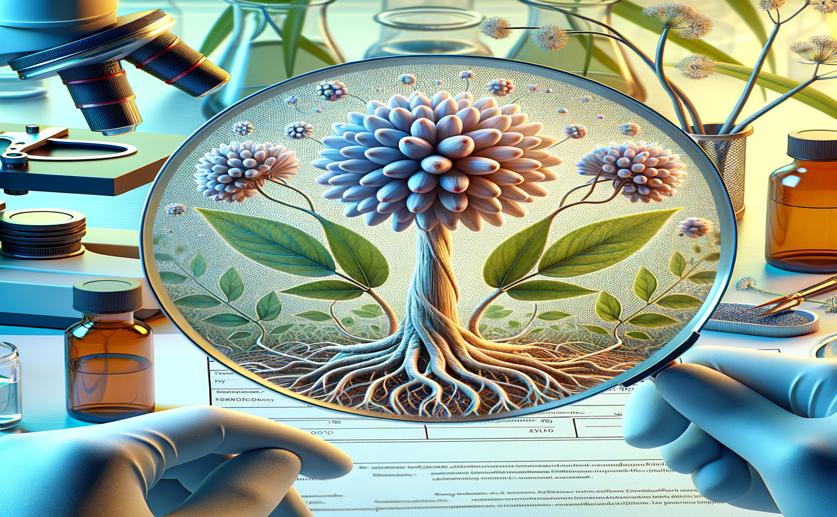Creating Rare Ginsenosides from Panax Notoginseng Using a Special Fungus

Image Source: Natural Science News, 2024
Key Findings
- Researchers at Kunming University of Science and Technology used the fungus Aspergillus fumigatus to transform Panax notoginseng saponins into 14 different rare ginsenosides
- The transformed ginsenosides include compounds with moderate antimicrobial activities against Staphylococcus aureus and Candida albicans
- This study paves the way for large-scale production of rare ginsenosides, enhancing their use in functional foods and pharmaceuticals
Panax notoginseng, a traditional Chinese medicinal herb, is known for its therapeutic properties, particularly in treating conditions such as depression[2]. The main active components of Panax notoginseng are its saponins (PNS). However, these saponins must be converted into rare ginsenosides by human gut microbiota and gastric juice before they can be effectively absorbed into the bloodstream and exert their medicinal effects. Unfortunately, the availability of these rare ginsenosides in Panax notoginseng and other medicinal plants is very limited, which restricts their use in functional foods and pharmaceuticals.
A recent study conducted by the Kunming University of Science and Technology aimed to address this limitation by exploring the production of rare ginsenosides through the biotransformation of PNS using the fungus Aspergillus fumigatus[1]. Over a period of 50 days at 25°C and 150 rpm, A. fumigatus successfully transformed PNS into 14 different products. These products were isolated using various chromatographic methods, including silica gel column chromatography, Rp-C18 reversed phase column chromatography, semi-preparative HPLC, and Sephadex LH-20 gel column chromatography. The structural elucidation of these products was achieved through 1H-NMR, 13C-NMR, and ESIMS spectroscopic analyses.
The transformed products were identified as ginsenosides Rk3, Rh4, 20(R)-Rh1, 20(S)-Protopanaxatriol, C-K, 20(R)-Rg3, 20(S)-Rg3, 20(S)-Rg2, 20(R)-R2, Rk1, Rg5, 20(S)-R2, 20(R)-Rg2, and 20(S)-I. Among these, compounds C-K and 20(S)-Rg3 exhibited moderate antimicrobial activities against Staphylococcus aureus and Candida albicans, with minimum inhibitory concentration (MIC) values of 6.25 and 1.25 μg/mL, and 1.25 and 25 μg/mL, respectively. This study not only expands our understanding of the biotransformation capabilities of Aspergillus fumigatus but also lays the groundwork for the large-scale production of rare ginsenosides, which could significantly enhance the functional and economic value of Panax notoginseng.
Previous studies have shown that the transformation of major ginsenosides into minor ones can be efficiently achieved using microbial strains. For instance, Cladosporium xylophilum has been used to convert major ginsenosides in Panax notoginseng flowers into minor ginsenosides, resulting in products with higher pharmacological activity[3]. Similarly, the optimization of fed-batch fermentation using Aspergillus tubingensis has been shown to enhance the biotransformation of ginsenosides in American ginseng extract into Compound K (C-K), one of the most bioactive ginsenosides[4]. These studies underscore the potential of microbial biotransformation in producing rare and highly active ginsenosides.
The current study by Kunming University of Science and Technology builds on these earlier findings by demonstrating the effectiveness of Aspergillus fumigatus in transforming Panax notoginseng saponins into a variety of rare ginsenosides. This transformation process not only improves the bioavailability of these compounds but also opens up new avenues for their application in functional foods and pharmaceuticals. The identification of antimicrobial activities in some of the transformed products further highlights their potential therapeutic benefits.
In summary, the biotransformation of Panax notoginseng saponins by Aspergillus fumigatus represents a significant advancement in the production of rare ginsenosides. This study not only enhances our understanding of the transformation pathways but also provides a foundation for the large-scale production of these valuable compounds, thereby expanding their potential applications in medicine and health.
BiotechBiochemPlant Science
References
Main Study
1) Production of rare ginsenosides by biotransformation of Panax notoginseng saponins using Aspergillus fumigatus.
Published 9th August, 2024
Journal: Bioresources and bioprocessing
Issue: Vol 11, Issue 1, Aug 2024
Related Studies
Related Articles





 20th July, 2024 | Jenn Hoskins
20th July, 2024 | Jenn Hoskins